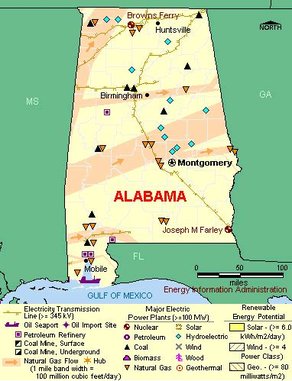Energy profile of Alabama, United States
Contents
Quick Facts
- Although it produces large amounts of coal, Alabama relies on deliveries from other States to meet roughly half of State demand.
- Alabama produces natural gas largely from wells offshore in Gulf of Mexico and from coalbed methane deposits, found primarily in the Black Warrior Basin and the Cahaba Coal Field.
- With numerous dams along the Alabama and Coosa Rivers, Alabama is one of the largest hydroelectric power-producing States east of the Rocky Mountains.
- Alabama’s soil is well suited for growing switchgrass, making the State a potential site for the installation of bioenergy plants.
Overview (Energy profile of Alabama, United States)
Resources and Consumption
 Map of Alabama's energy infrastructure. (Source: EIA)
Map of Alabama's energy infrastructure. (Source: EIA) Alabama is rich in energy resources. The State has considerable conventional and unconventional natural gas reserves, substantial deposits of coal, and numerous rivers capable of hydroelectric generation. Several regions of Alabama are well suited for growing switchgrass, making the State a potential site for the installation of bioenergy plants. With a strong manufacturing base in paper products, chemicals, and textiles, Alabama’s industrial sector leads State energy consumption, accounting for nearly one-half of total energy use.
Petroleum
Alabama produces a small amount of crude oil from reserves located in the Black Warrior Basin in the north and the Gulf Coast in the south. Although production has been in decline since the early 1990s, high oil prices have sparked new onshore drilling activity in recent years. To increase production from aging fields, producers have repaired old wells and applied new technology. Two petroleum refineries (Petroleum refining) are located near the Port of Mobile, and a third is located in Tuscaloosa on the Black Warrior River. A fourth refinery is located in Atmore in the southern part of the State. Alabama markets receive finished petroleum products from Texas and Louisiana through the Colonial and Plantation pipelines. Per capita petroleum consumption in Alabama is about average compared to other States.
Natural Gas
Alabama’s annual natural gas production accounts for more than 1 percent of total U.S. output. More than one-half of this production typically comes from offshore wells, and more than one-third comes from coalbed methane deposits (unconventional natural gas found trapped within coal seams) in the Black Warrior Basin and the Cahaba Coal Field. As with oil production, Alabama’s natural gas production is in decline and does not satisfy all consumer demand, about three-fourths of which is from industrial users and electric power generators. Consequently, Alabama purchases additional supplies of natural gas transported by pipeline from Louisiana and Texas.
Coal, Electricity, and Renewables
Alabama ranks high among States in electricity generation. Coal is the dominant fuel for electric power generation, typically accounting for more than one-half of the electricity produced within the State. Although Alabama produces large amounts of coal in the northern part of the State, industry consumes most of the State’s output. Coal used for electricity generation is shipped in from other States, primarily Wyoming and Kentucky. Alabama is a major nuclear power generator, and in 2005 its two nuclear power plants produced about one-fourth of the electricity generated in the State. The State’s nuclear power capacity is expected to expand in mid-2007 when the Tennessee Valley Authority (TVA) restarts a nuclear reactor at its Browns Ferry nuclear power plant that has been idle since 1985. With more than two dozen hydroelectric dams, located mainly along the Alabama and Coosa Rivers, Alabama is the one of the top producers of hydroelectric power east of the Rocky Mountains. Hydroelectric power typically supplies at least 6 percent of State electricity generation.
Due to high demand from the industrial and residential sectors, Alabama’s total electricity consumption is high when compared to other States. Alabama’s per capita consumption of residential electricity is one of the highest in the country due to high air-conditioning demand during hot summer months and the widespread use of electricity for home heating during generally mild winter months. However, despite high total and per capita electricity demand, Alabama electricity production exceeds consumption and the State exports large amounts of electricity to neighboring States via several high-voltage interstate transmission lines.
Data
See the Energy Information Administration's Energy profile of Alabama for more information on the state's energy use, including data on Economy, Prices, Reserves & Supply, Distribution and Marketing, Consumption, and Environment.
Related Reports
- State Consumption, Prices and Expenditures (SEDS) tables that display comprehensive State data from as early as 1960 to the present.
- State Electricity Profiles tables that provide time series data from 1990 forward for key electricity indicators by State.
- State Compendium of Nuclear Power Plants State-by-State reports on the nuclear industry.
- Natural Gas Residential Choice Programs written overviews of the status of natural gas industry restructuring in each State, focusing on the residential customer class.
- Status of Electricity Restructuring by State annotated map showing details of the status of electricity restructuring in each State.
- Regional Energy Profiles reports and maps that explore regional variations in U.S. energy consumption.
References
- Notes & Sources: Maps | Data
- State Data Directory
- About State Energy Profiles
| Disclaimer: This article is taken wholly from, or contains information that was originally published by, the Energy Information Administration. Topic editors and authors for the Encyclopedia of Earth may have edited its content or added new information. The use of information from the Energy Information Administration should not be construed as support for or endorsement by that organization for any new information added by EoE personnel, or for any editing of the original content. |